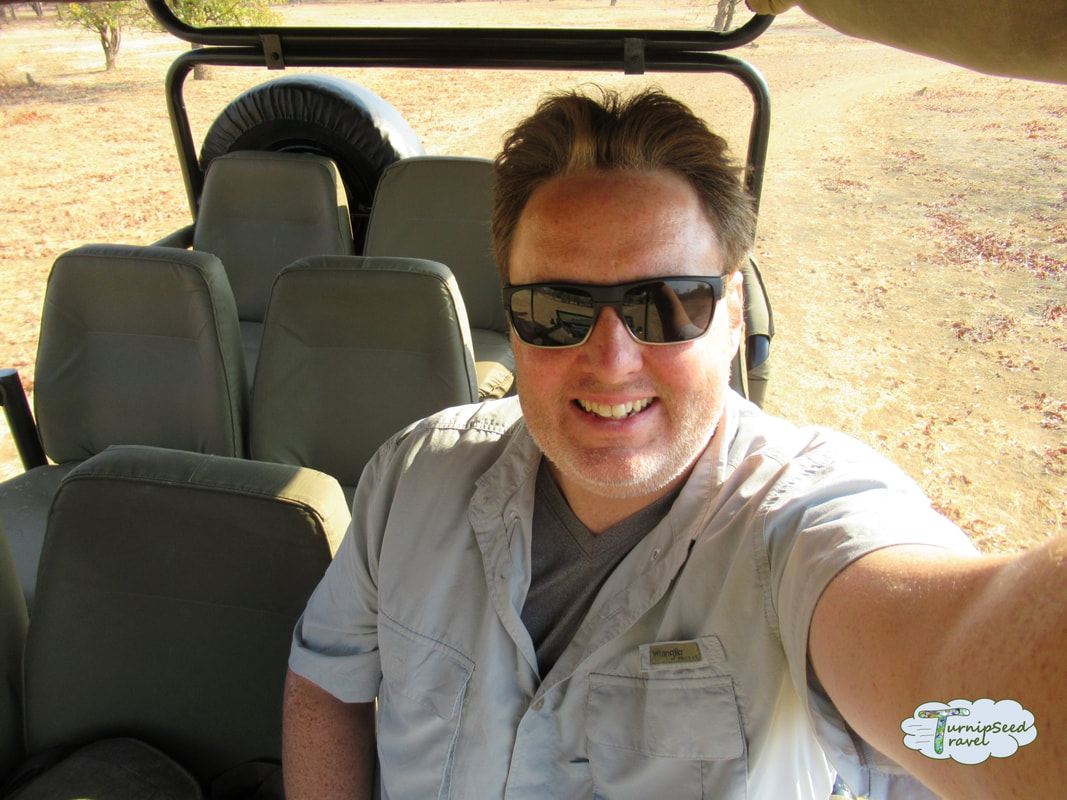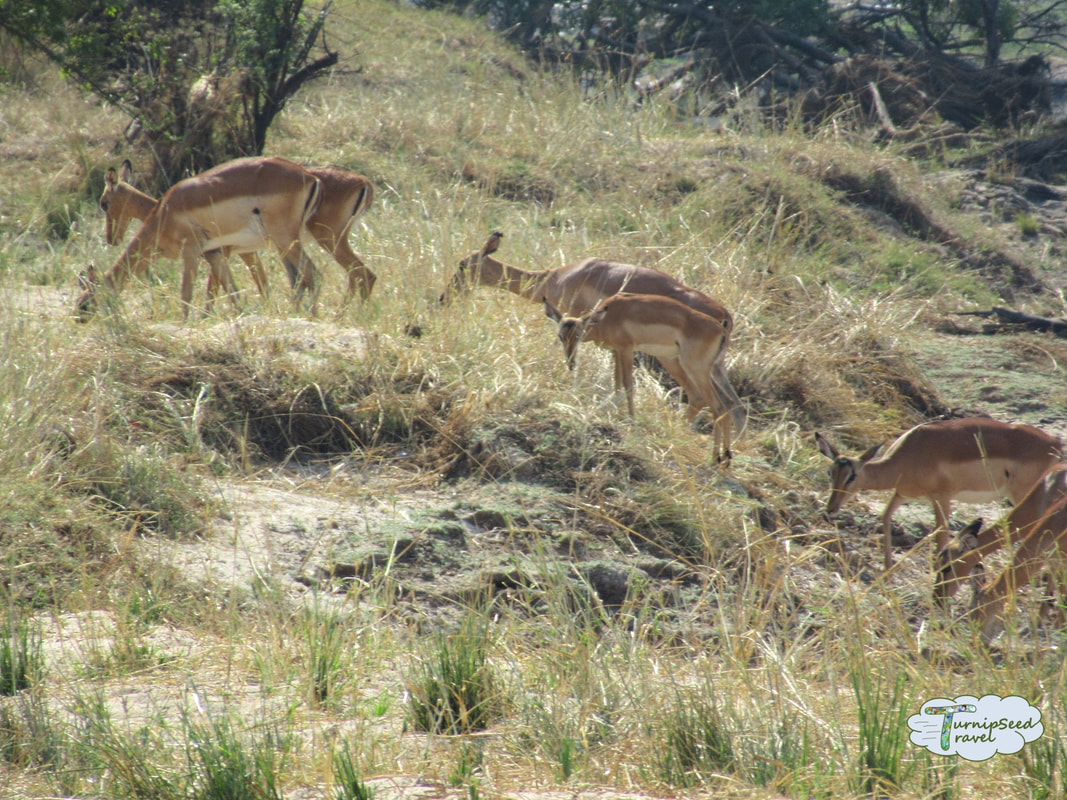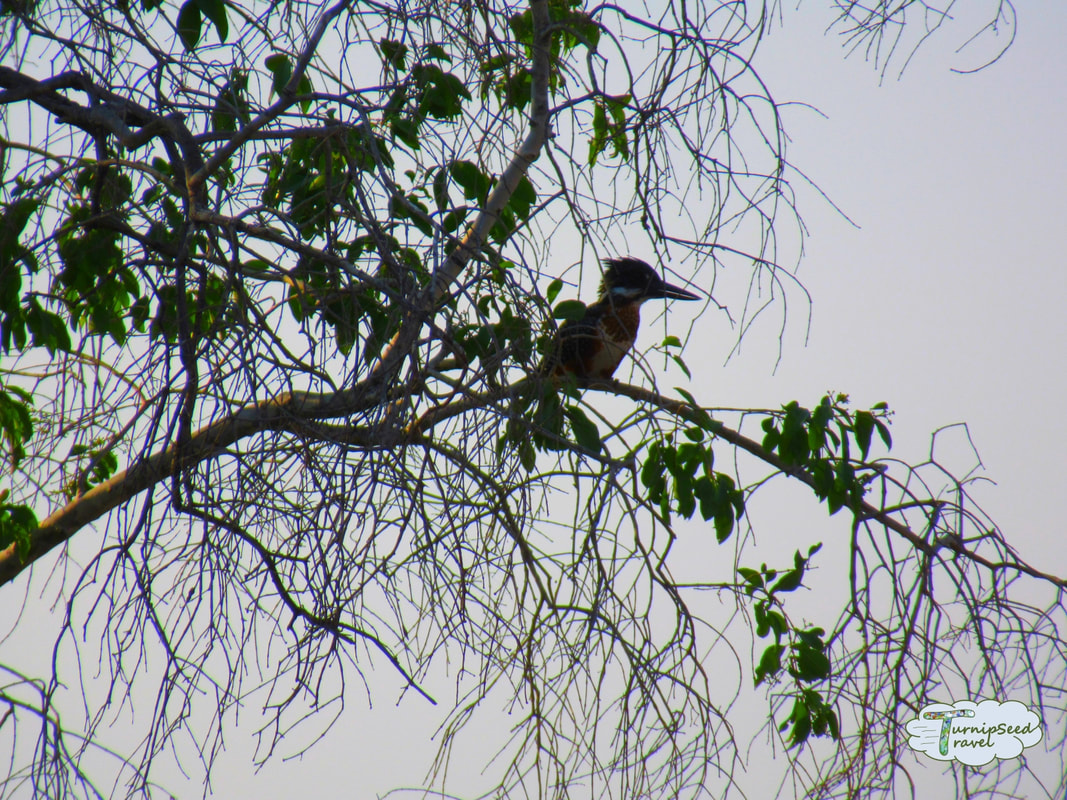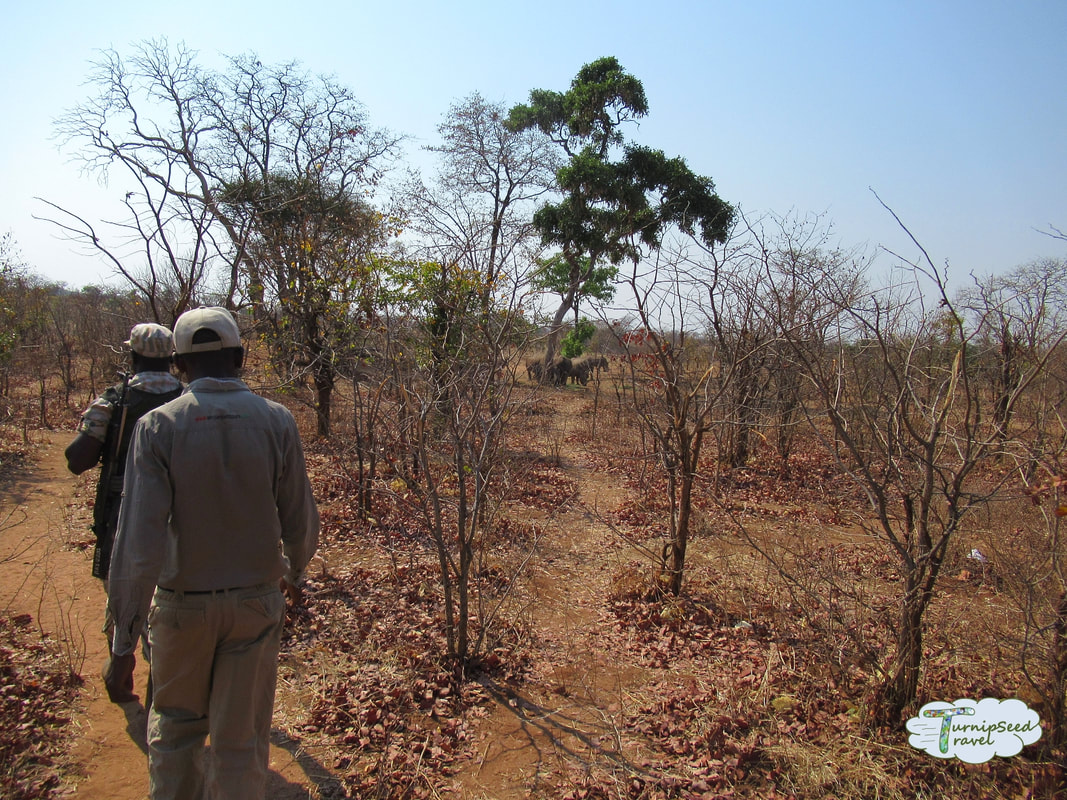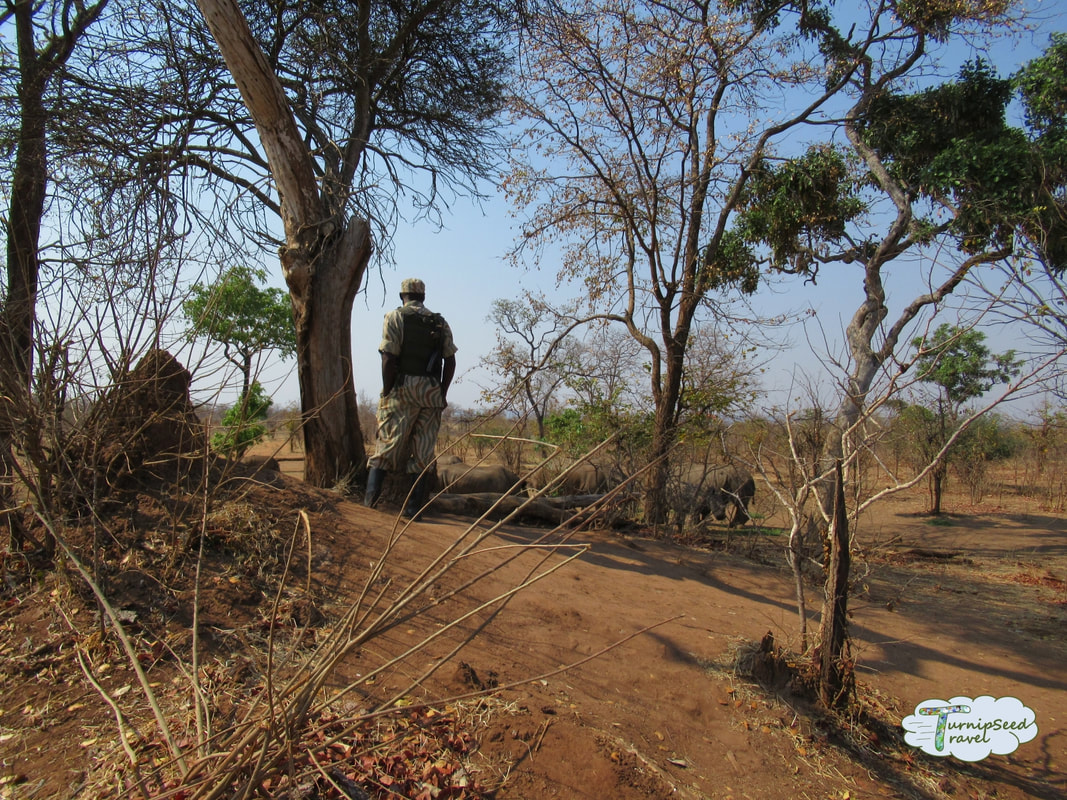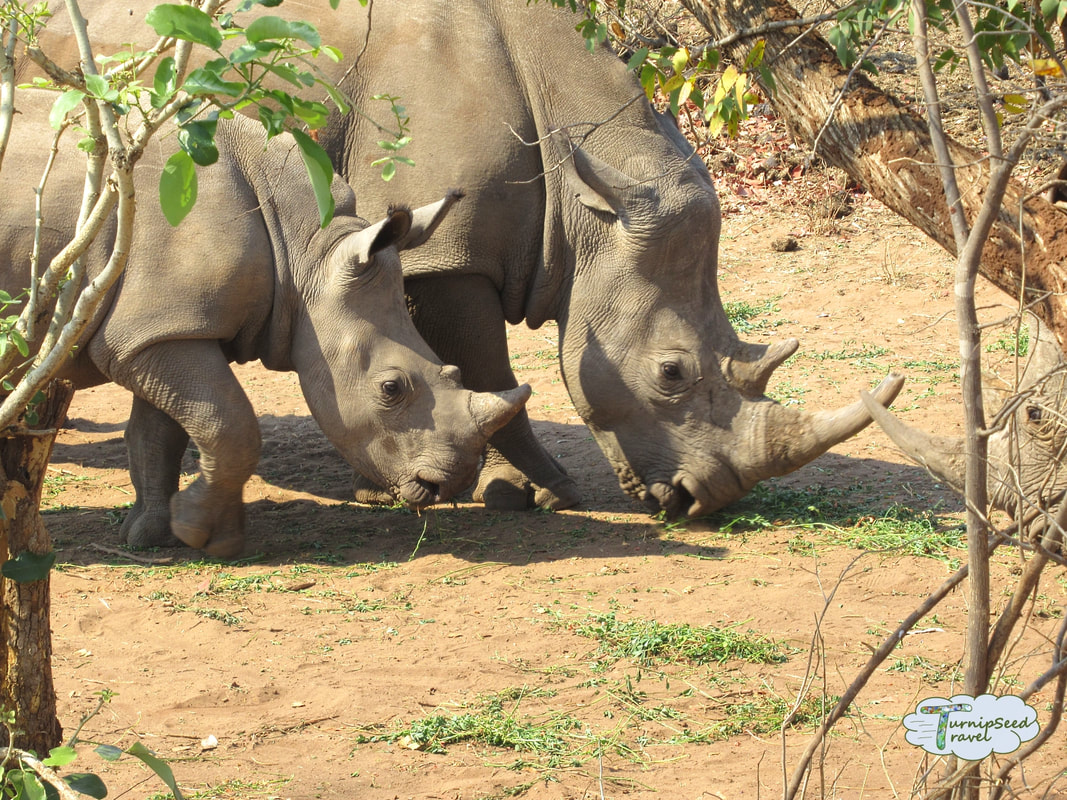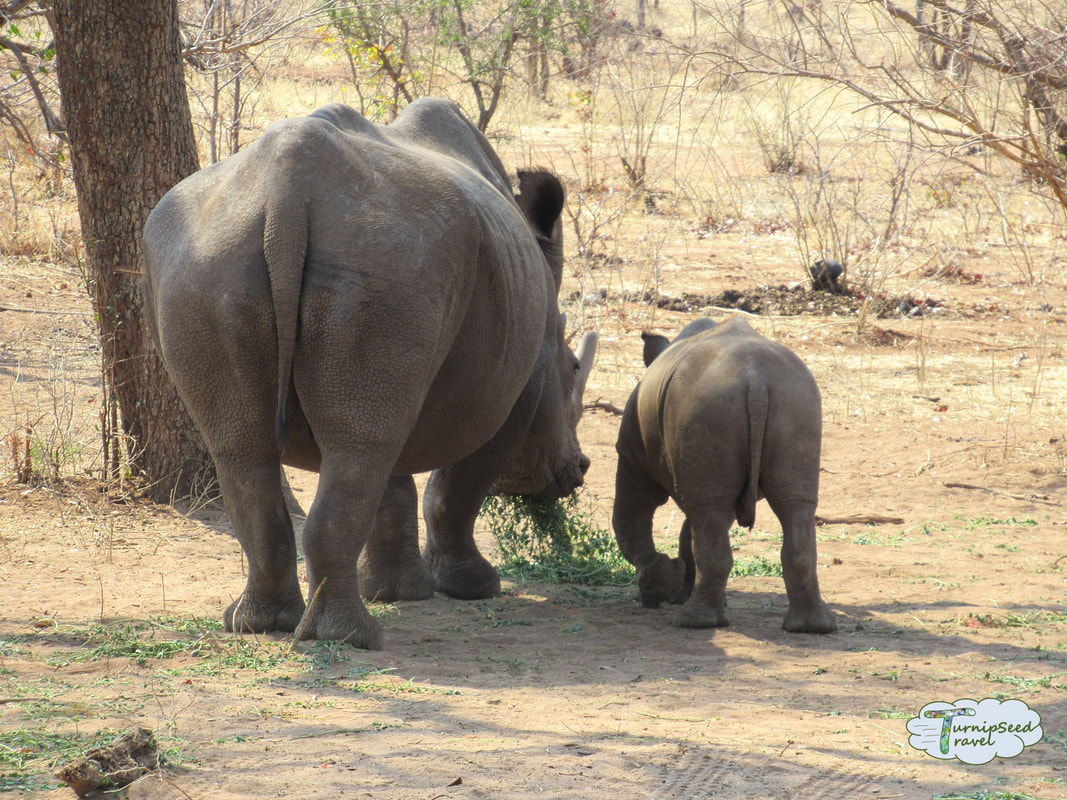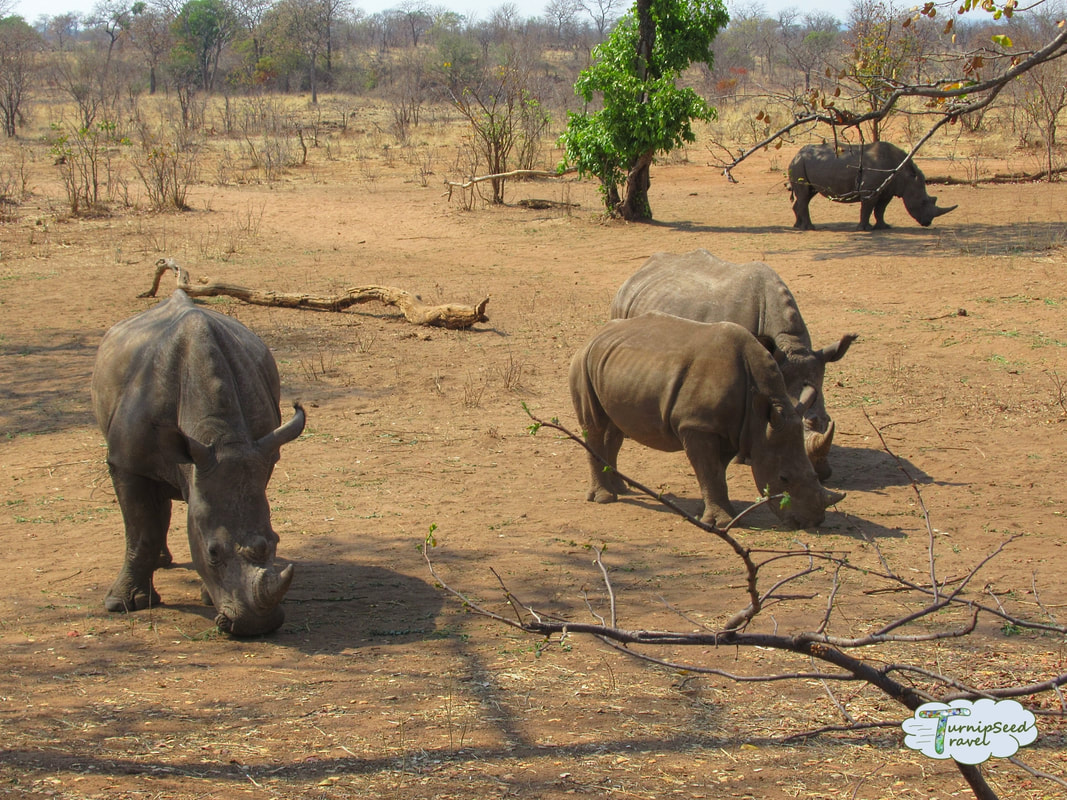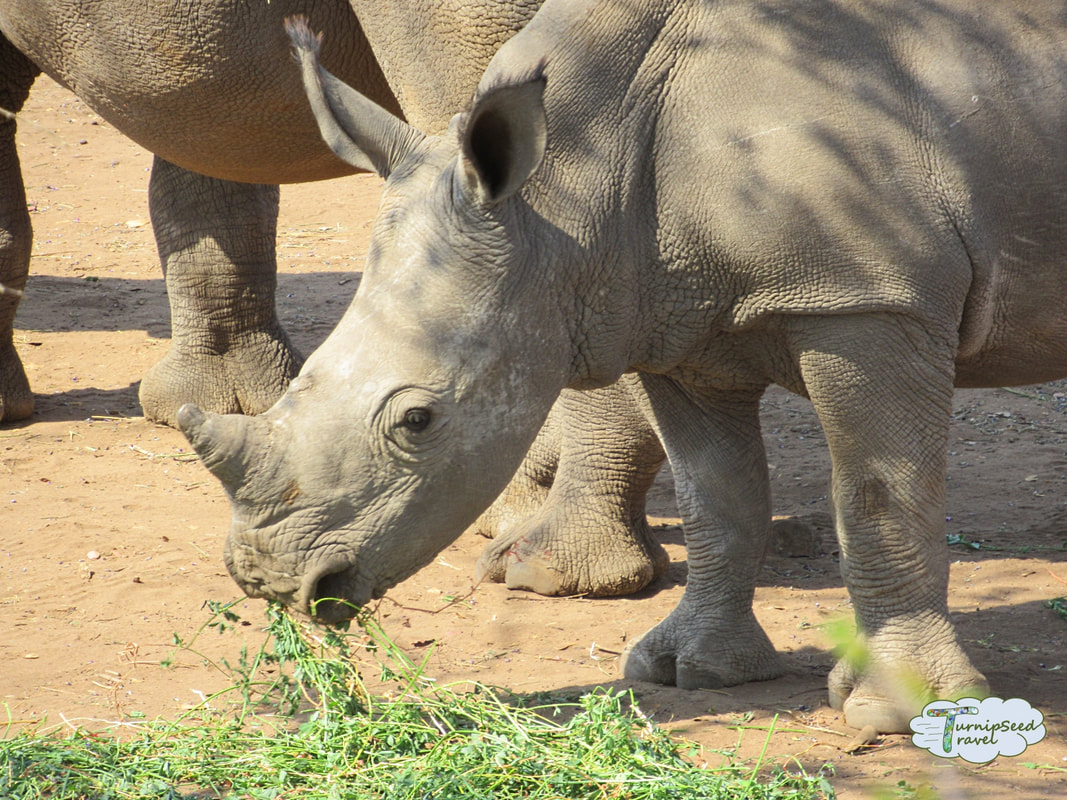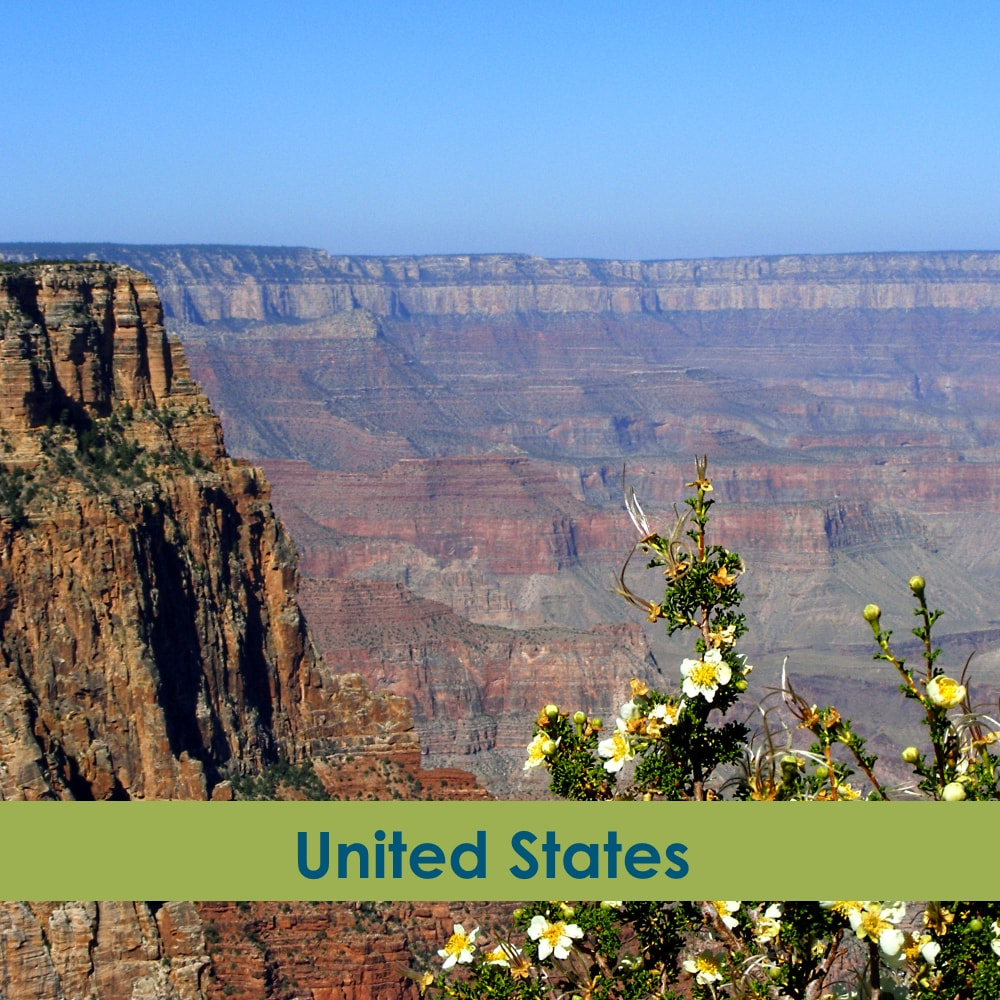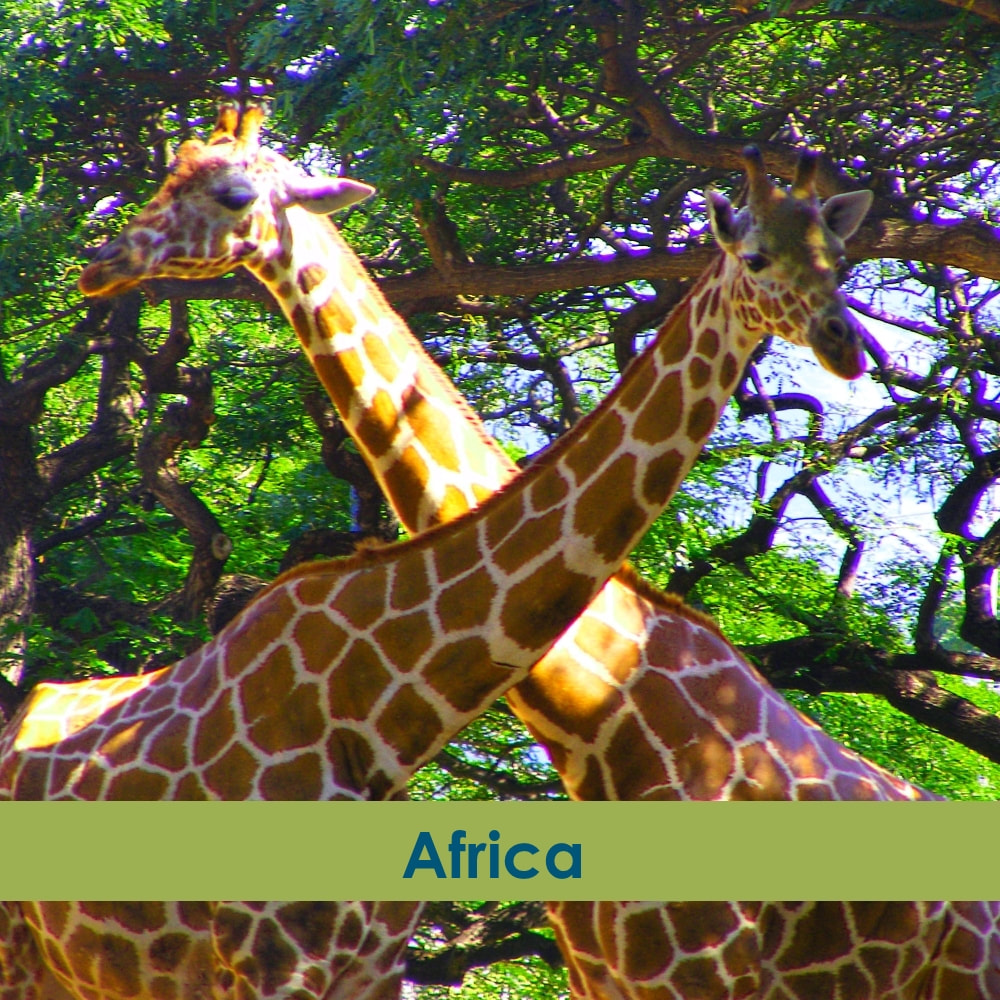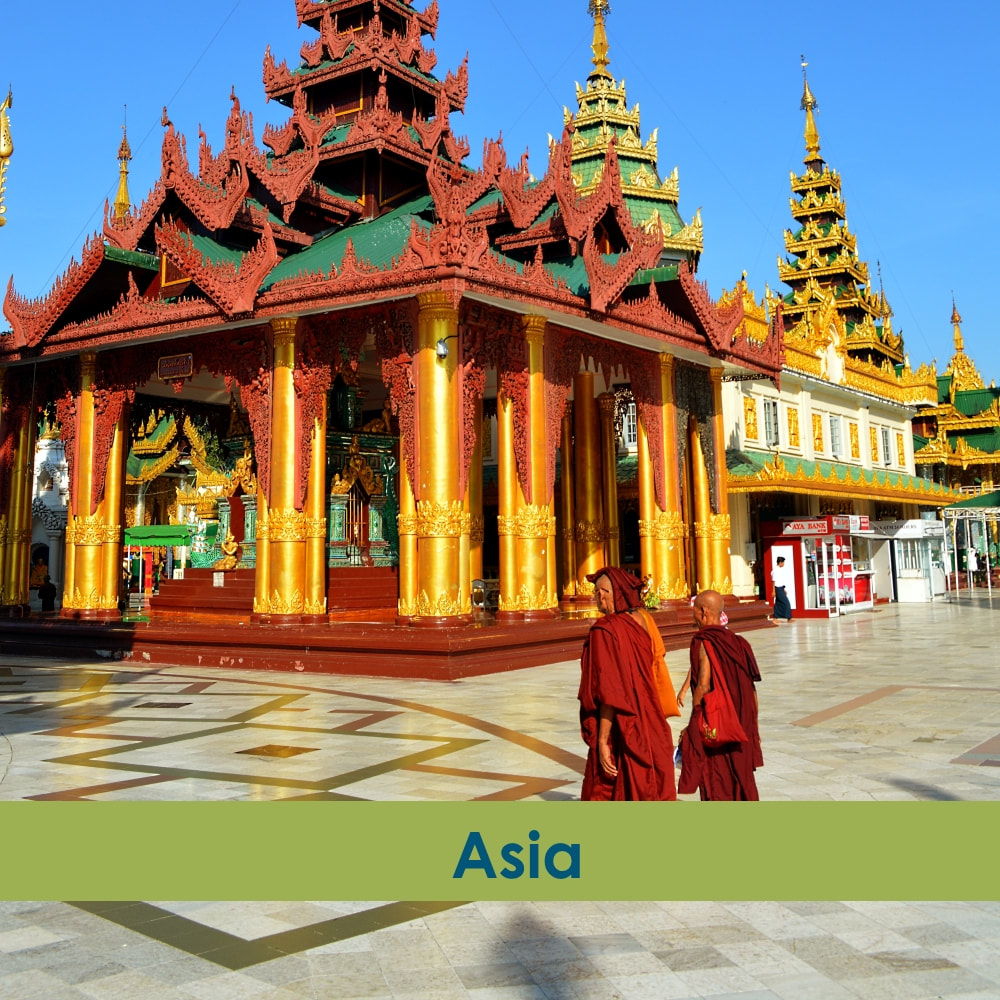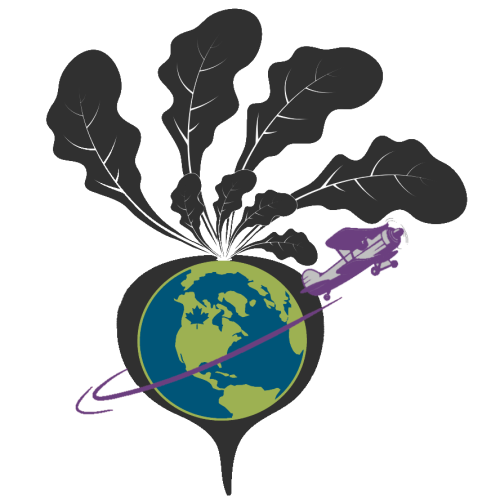Do you dream of walking on the wild side? A rhinoceros safari walk in Zambia is for you!Some links within this blog post are affiliate links, which means we are paid a small commission should you make a purchase.
When is it good manners to snort, grunt, and guzzle your food with no regard to your company? Only when you're a wild rhinoceros and your guests are part of a walking safari! This walk on the wild side definitely stands out as one of the most unique and exciting things we've ever done.
A walking rhinoceros safari can only be experienced in Livingstone, Zambia, at Mosi-oa-Tunya National Park. "Mosi-oa-Tunya" translates to "the smoke which thunders" in reference to the power of Victoria Falls. And during our visit, it wasn't just the water which was thundering. Between our beating hearts and the stomping of feet and hooves, there was a lot going on during our morning with the rhinos. You'll love this special National Park
At about 66 square kilometers, Mosi-oa-Tunya National Park is the second smallest national park in Zambia. The park is roughly divided into two sections, one of which is used primarily for viewing the waterfalls and scenery of Victoria Falls. The other part is a nature reserve used for game drives and walking safaris to see the southern white rhinoceros. It was here that we started our adventures.
We weren't the only tourists in the park. The southern white rhinoceros of Mosi-oa-Tunya National Park are actually tourists too - they're native to South Africa, not Zambia. Zambia's indigenous rhinoceros species is the black rhinoceros and, while once thought extinct, they are now found in North Luangwa National Park as part of a reintroduction pilot project. But black and white rhinoceros alike face constant danger. These critically threatened animals are the cream of the crop as far as poachers are concerned. Rhinoceros horns are highly valued on the black market, where they are worth their weight in gold. The horn - which is made of keratin just like human finger nails - is reputed to have therapeutic benefits. But we'll get to that in a moment! Organizing your tour
In order to see the southern white rhinoceros in Zambia's Mosi-oa-Tunya National Park, you have to enter the park through one of just a couple of approved tour providers. We had absolutely no problem arranging this with our hotel one day in advance and we saw rhino safaris advertised with most major third party tour companies as well. Booking is simple and easy.
We spent $85 US each, plus more on tips for our guide and our park ranger. The price was in keeping with similar wildlife excursions in the area but it was still a major splurge for. In my view, it was worth it. And as luck would have it, we were the only two people who had booked the excursion. An unexpected private tour? Yes, please! After chatting with other travelers, we learned that some tours - like ours - started with a game drive and then concluded with a short walk to see the rhinoceros. Others featured a long walking safari experience in lieu of the game drive. If you prefer one style versus the other, be sure to clarify your preference with your hotel activity desk provider. We were very comfortable and enjoyed our game drive but I can see how other people might be a bit surprised to learn that the walking component of their particular tour was brief. In either case, your experience should include a cooler of non-alcoholic drinks, a very light snack (we had a container of potato chips to share), hotel pick up and drop off, and the admission fee for Mosi-oa-Tunya National Park. Be sure to confirm the later, as national park admission fees are about $20 US a person. We've also saw some packages that included lunch or breakfast as an add on. We were given the choice of an early morning or late afternoon tour and we were very happy with our early morning choice. The weather was marginally cooler - and every degree makes a difference! Meeting furry friends on the game drive
While we were ridiculously excited to see our rhinoceros friends, we soon settled into the game drive as our guide quickly started pointing out many animals. Impala and beautiful birds were plentiful, while the elephants were a bit more shy (though we still saw them!)
If elephants are high on your list - and why wouldn't they be? - you'll have an advantage if you visit during the dry season as they migrate over from Zimbabwe. Unfortunately, we didn't see giraffe or buffalo during our drive, but they're present in the park year round. However, if you're keen on cats, you'll be out of luck. There are no lions or leopards here.
Our guide's sharp eyes revealed far more animals than we ever would have seen on our own. We saw warthog, zebra, monkeys, baboons, vultures, impala, and more. He was keen to learn what animals and plants we were most interested in and went out of his way to point out things he knew we'd like, like finding a baobab tree for me.
While the larger animals weren't as prevalent as they were in Chobe National Park (Botswana), we were amazed by how much we saw and how much we learned in a short amount of time. Even without meeting the rhinoceros, it was a great game drive and we'd hugely recommend it to anyone visiting the area. In particular this would be the perfect activity for anyone who had a Victoria Falls layover with a short amount of time. Time to meet the rhinos!
After about two hours of exploring, we took a short refreshment break. And then it was time to visit the rhinoceros! We drove to the appointed spot and were met by two armed park rangers. They reviewed the rules and procedures with us. We were to walk in single file and not break ranks. Talking calmly and quietly was important. If we were startled or scared, we were not to run under any circumstances. We set off in the direction of some nearby grunting noises, with one ranger in the front and another bringing up the rear. We were soon met by a third armed ranger.... and TEN delightful southern white rhinoceros!
Just look at these beautiful creatures! We were instantly captivated by their large ears with fuzzy edges. We learned that while their eyesight isn't good, rhinoceros have excellent hearing. They were thoroughly engrossed in eating greenery and didn't pay the least bit of attention to us. (Same, rhinos. Same. I like food a lot more than people too!)
There was a lot of snorting, grunting, and occasionally even headbutting, but it was all in the name of securing a better assortment of leaves. Us nearby humans weren't even an afterthought. Some fallen trees provided a natural barrier between us and the animals, adding an extra layer of security (apparently hopping over fallen trees is not the rhino's strong suit.)
So are rhinoceros horns therapeutic? Absolutely they are! Seeing them attached to LIVING rhinoceros made me feel happier and healthier than ever before. I'm certain that my blood pressure dropped, my circulation improved, and my senses have never been more acute. I felt tremendously revitalized and I highly recommend a hearty dose of rhinoceros horn to all travelers - the key is that it remains attached to its owner for the ultimate high!
We were with the ten southern white rhinoceros (including a baby and a pregnant mama!) for approximately 15 minutes and had plenty of time for photos and our guide also was able to take photos of us. The guide and the park rangers patiently answered all of our questions and we loved having the opportunity to learn more about their work and the park. It was an unforgettable moment and a highlight of our time in Zambia.
If you're heading to Zambia, here are practical tips to make your rhino safari experience a smooth one....
If you enjoyed this article, you'll also like: Inside Our Round-The-World Flights Booked On Points Our Favourite Non-Liquid, TSA Friendly Toiletries Travel Gear Review: First Aid Kits Comments are closed.
|
�
Recent Posts
Posts by Location
Post Categories
All
Posts by Date
June 2024
|
Disclaimers, Privacy, and Cookie Policy |
Top 100 Travel Influencer
As named by the Obama White House in 2014. |
© COPYRIGHT 2024. ALL RIGHTS RESERVED.
|




